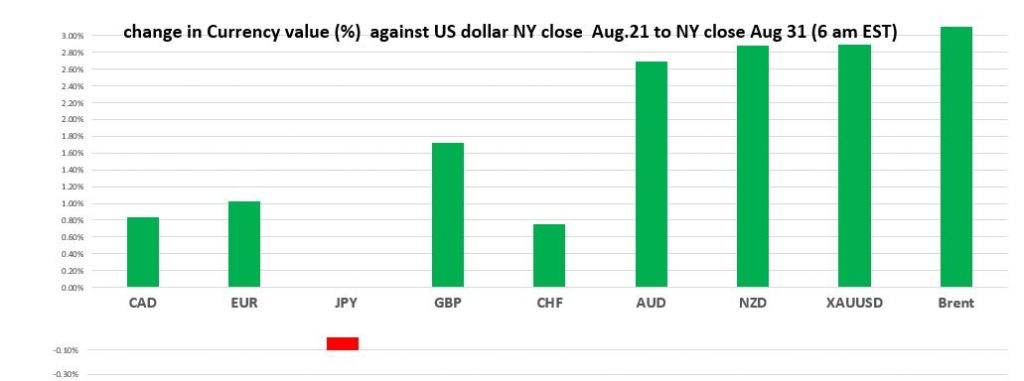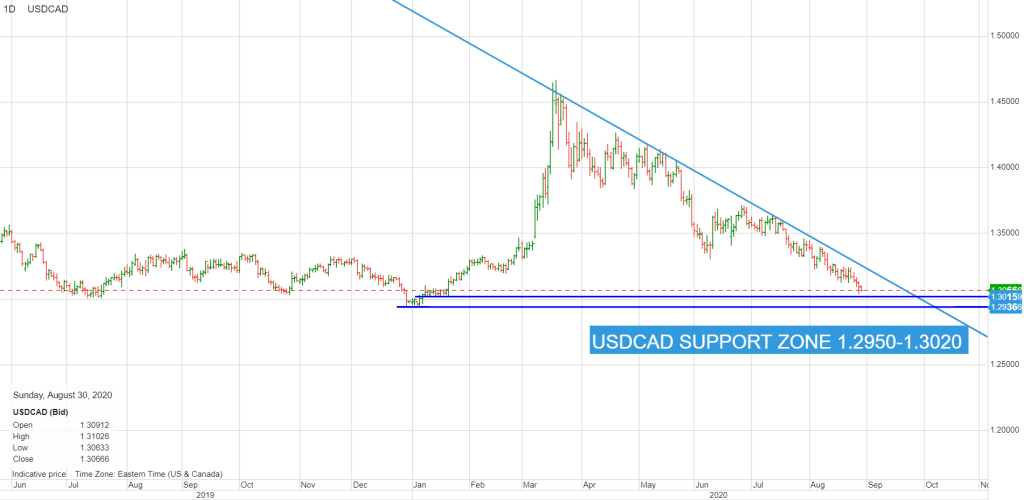
Photo: Marco Verch
August 31, 2020
USDCAD Open (6:00 am) 1.3066-70, Overnight Range 1.3068-1.3103
- FX markets steady with UK closed for holiday
- China PMI data steady, growth powered by domestic demand
- US dollar ending August with losses against G-10 currencies, except vs JPY

Source: Saxo Bank/IFXA Ltd
FX Recap and outlook: The arrival of September tomorrow, heralds a return to improved FX liquidity conditions. Holidaymakers return to work, and many traders return to their workstations. It should mean reduced FX volatility. Unfortunately, improved liquidity may not be noticeable this week, due to the release of the US employment report Friday and the European Central Bank (ECB) meeting the following Monday.
The US dollar closed in New York on Friday with losses against the G-10 majors, led by a 3.1% gain in NZD. The Fed’s shift to Average Inflation Targeting around 2.0% from a 2.0% inflation goal reinforced forecasts that US interest rates would remain low for an extended period, and that exacerbated US dollar selling pressure.
The US dollar may be ending the month, with losses across the board but it managed to squeeze higher since Friday’s close. Only CAD and EUR opened higher following a quiet European trading session. It was a Bank Holiday in the UK and markets were closed.
EURUSD opened in NY near the top of its 1.1885-1.1928 range. Euro-area data was sparse and with the UK closed, trading volumes were light. Traders were also looking ahead to next week’s ECB meeting with concerns that they will follow the Fed’s lead and ramp up discussions about Average Inflation Targeting. US tariffs on EU goods start Tuesday, which may limit topside moves.
EURUSD technicals are bullish above 1.1780, looking for a break above 1.1962 to extend gains to the 1.2020 area. However, topside gains may be slow as IMM position data reports EURUSD longs are at another all-time high.
GBPUSDsuffered from EURGBP demand and prices dropped to 1.3303 from 1.3368, before climbing to 1.3320 in NY. Prices continue to consolidate last week’s gains after GBPUSD climbed from a low of 1.3055 on Monday to 1.3368 today. Month-end positioning flows were a significant driver of the gains.
This week’s price action may be driven by Brexit sentiment where the UK/EU talks continue to be just noise and no action. Traders have ignored comments by Bank of England Governor Andrew Baily reminding markets that the monetary policy toolbox contains negative interest rates. August Manufacturing PMI is expected at 55.3
GBPUSD technicals are bullish and trading above the 2020 peak of 1.3265. The July uptrend channel lower boundary is 1.3120 with the upper limit at 1.3500. The daily Bollinger band and RSI suggest GBPUSD is overbought and vulnerable to a retest of support at 1.3175.
USDJPY scraped along the bottom of its overnight 105.30-105.96 range in Asia, then climbed to open in NY near the top, tracking higher US Treasury yields. 10-year Treasury yields rose to 0.744% from 0.634% last Monday.
AUDUSD was steady and NZDUSD rallied after China PMI data was released. AUDUSD traders are looking ahead to Tuesday’s RBA monetary policy meeting.
USDCAD is trading with a bearish bias, falling from 1.3103 in Asia, to a low of 1.3067 in NY today. The selling is likely due to month end portfolio manager demand for Canadian dollars which, should disappear after 11:00 am today.
The US and Canadian economic calendars are empty.
USDCAD Technicals: USDCAD technicals are bearish below 1.3230 targeting a move below support at 1.3020 to extend losses to 1.2940. A move above 1.3230 would suggest a short-term bottom is in place and lead to 1.3000-1.3500 consolidation.
For today, USDCAD support is at 1.3030 and 1.2990. Resistance is at 1.3105 and 1.3130. Today’s Range 1.2990-1.3080
Chart: USDCAD daily

Source: Saxo Bank
FX open (6:00 am EDT) High, Low, and previous close Source: Saxo Bank






